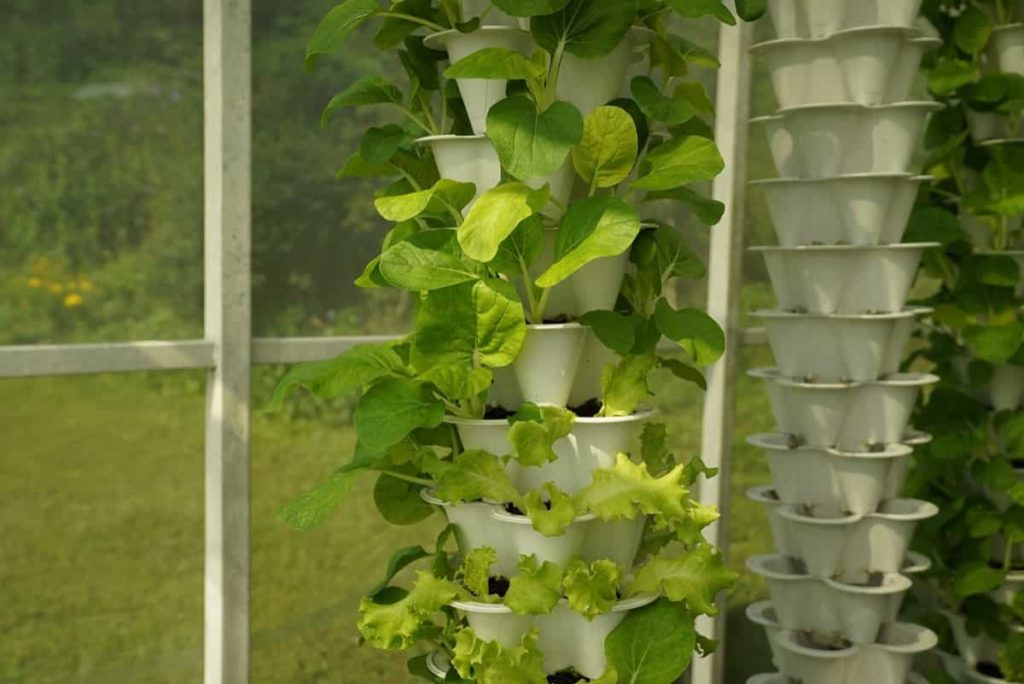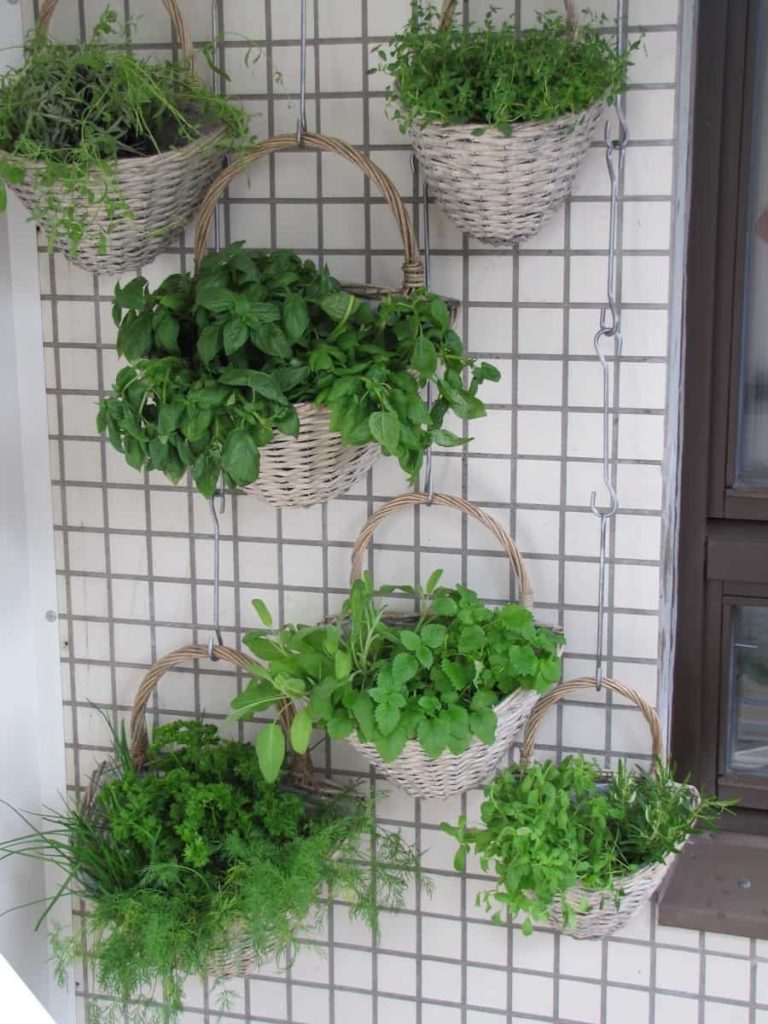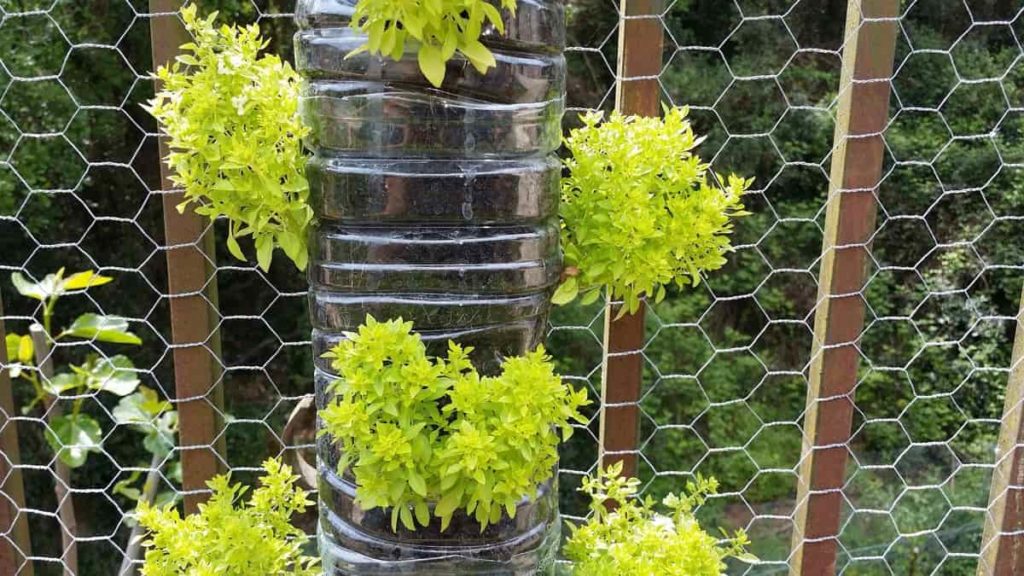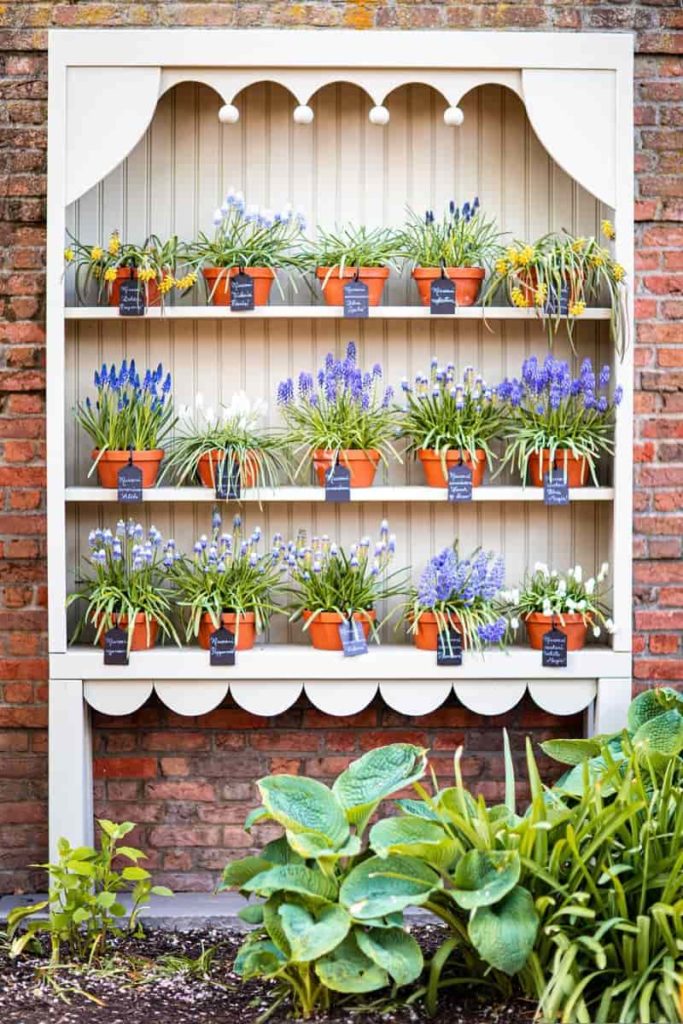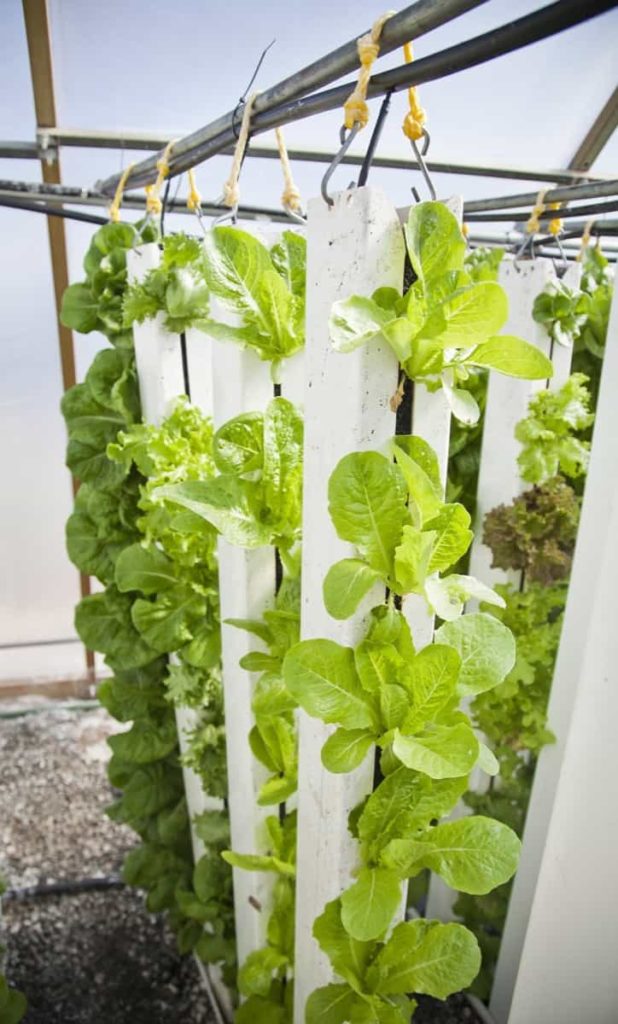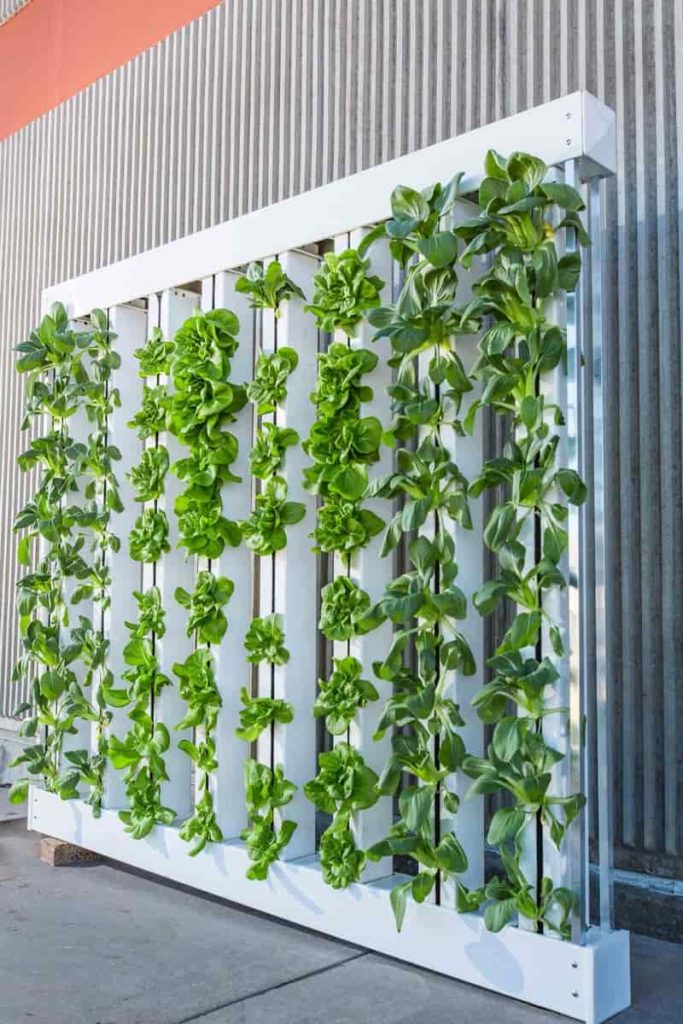An indoor vertical garden is sometimes called a wall garden, a living wall, or a living wall planter. It is because you mainly use vertical space to fulfill your desire to grow plants. It is a technique used to grow plants on vertically suspended panels, which can be either self-supporting or attached to a wall. Indoor vertical gardens have been around for a long time and are known by different names, like living green walls, moss walls, and living walls. Indoor vertical gardens should be attached to strong supports.
Pots filled with plants and moist potting mix are heavy. You could want to protect the supporting wall behind the vertical garden with a sheet of plywood. Alternatively, protect the wall from moisture with a polyethylene cloth. When you design a vertical garden, it’s important to have a clear design in mind that considers the space it’s placed in, the amount of light it gets, and how long you want to maintain it. It is safe to assume that people will want to create a vertical garden that is as low-maintenance as possible.
Low-maintenance indoor vertical garden ideas, tips, techniques, and secrets
Hydroponic indoor vertical garden
It is a vertically suspended panel on which plants are grown using hydroponics. These unique structures can be either freestanding or attached to a wall and go by many names, like living green walls, plant walls, and moss walls. These vertical garden structures of plant life can be as small as a picture frame or large enough to cover an entire wall.
Hydroponic vertical systems that allow plants to grow vertically are called vertical hydroponics. Vertical hydroponics uses traditional hydroponic techniques in a vertical, gravity-fed system. Nutrient-rich water is fed to the plants from the top and collected at the bottom.
Are vertical gardens easy to maintain?
Potted plants provide flexibility in space, but they take up space and require a lot of maintenance. Vertical gardens take up little, if any, floor space. Vertical gardening produces a lot of food in a small amount of space. Hundreds of things can be grown vertically, producing large crops from just a few square feet of space. Indoor vertical gardens have numerous benefits.
These gardens offer several aesthetic, financial, physical, and environmental advantages over conventional gardens. A vertical garden can maximize and utilize every square foot of space, especially in crowded and tight metropolitan locations. Also, it is a great way to grow food in areas with limited space. Vertical gardening is not difficult indoors, and hundreds of plants are suitable for growing vertically indoors.
Tips for maintaining an indoor vertical gardening
- An irrigation system is an important component of a vertical garden
- Fertilizing a vertical garden is important in the long term
- Having sufficient light levels
- Best plants for vertical gardening
- Using plant design to minimize maintenance
- Time to trim
- Pest control
In case you missed it: How to Solve the Challenges of Urban Agriculture/Farming/Gardening
Choosing plants for an indoor vertical garden
Native plants are often a safe choice because they are adapted to local conditions. However, specific growing conditions in a vertical garden sometimes severely limit the use of native species only.
Vegetables – Beans, Carrots, Cucumbers (Small), Eggplant (Miniature), Garlic, Onion (Small), Pepper (Compact Varieties), Tomato (Cascading / Patio)
Herbs for sunny walls – Basil, Beebalm (Bergamot), Borage, Chervil, Chives, Cilantro, Cumin, Dill, Lemon Balm, Lemongrass, Marjoram, Mint, Nasturtium, Oregano, Parsley, Rosemary, Sage, Stevia, Thyme, and Wheatgrass.
Medicinal and Aromatic Plants – Aloe Vera, Borage, Calendula, Catmint, Chamomile, Echinacea, Goldenseal, Hyssop, Lavender, Patchouli, Fragrant Geranium, Sweet Woodruff, Yarrow
Lettuce – Whether you prefer Romaine, Arugula, Oak Leaf, or even Iceberg, Lettuce stays relatively small and is one of the easiest options for an indoor garden.
English ivy – English ivy is one of Europe’s most popular vines, a species of flowering plant in the family Araliaceae, native to much of Europe and western Asia. It is easy to grow in an indoor vertical garden.
Peace Lily – Peace lily is one of the popular indoor vertical growing plants classified under the Araceae plant family.
Snake plant – Snake plant is one of the hardiest and best indoor vertical growing plants that doesn’t need bright sunlight or frequent watering.
Lipstick Plant – The lipstick plant is a cascading plant with glossy green leaves and red, lipstick-shaped flowers that appear year-round. This hardy plant, one of the best indoor wall plants, tolerates low light and dry conditions like a champ.
Pothos – A low-maintenance plant with a graceful growth habit and heart-shaped leaves. Pothos tolerates almost any light, including bright sunlight or partial shade.
Requirements to start an indoor vertical garden
- To create an indoor vertical garden, you will need to:
- Decide what type of plants you want to grow.
- A sunroom with a large open window is perfect for most plants.
- Grow lights can be used to supplement sunlight if needed.
- Choose a vertical design that works best for your space and your needs. There are plenty of options, from wall-mounted pot holders to stackable self-watering systems.
- Building an indoor vertical garden can be a lot of fun and rewarding.
Things to know about indoor vertical gardens
1. Types – The first step toward creating an indoor vertical garden is deciding on a preferred design and style. Whether you want a pre-set live wall, a planter, or a wall-mounted shelf with a creative modular design, It’s up to you. An automated indoor vertical garden is also a low-maintenance option. All of these will require some installation and waterproofing.
In case you missed it: Herbs Growing Season Chart in India: Sowing Guide, Germination, and Planting Calendar
2. Placement – Ideally, indoor vertical gardens should be placed at a height from where they can be easily managed and maintained. Exposure to the sun and fresh air is also important when planning an indoor vertical garden.
3. Vertical Garden Supports – When deciding the support type for vertically growing plants, consider sun and wind exposure, maintenance requirements, and plant size. There are different types of support to choose from. In addition to arches, trellises, tripods, and pergolas, there are gazebos, wire cages, nets, bamboo poles, and more. Some growers have even invented ways to use 2-liter plastic soda bottles, gutters, and PVC pipes. Again, try to match the texture with the characteristics of the plant.
For example, plants with tendril leaves, such as pole beans and sweet peas, climb well on trellises – either purchased from a woodshed or made at home. More substantial plants, such as grape vines, benefit from a sturdy structure—perhaps an arch or pergola. Keep in mind that a structure should be able to accommodate the weight of a mature plant and be well anchored to prevent it from toppling over. Use strong; horizontal wire strung between fence posts to create the necessary support for wall-trained fruit.
4. Watering – The same basic principles apply to watering: whether your vertical garden is growing in the ground, on a patio, or hanging on a wall. Below are some watering tips;
- Water at the base – Watering the indoor plants at the base rather than the top will help prevent fungus and mildew growth. It also helps reduce weeds in a vertical garden plot since you’re only watering the plants, not all the weeds.
- Use an irrigation system – Adding irrigation to your garden is a lifesaver in watering. You can build soaker hoses through a plot or install drip irrigation. Once installed, plug the watering system into a digital hose timer to make the watering snap.
- Infrequent, deep watering – It’s better to water your vertical garden less frequently, with deeper water, than watering it a little each day. Deep watering encourages roots to grow deeper, so plants won’t need to be watered as often.
- Provide proper drainage – Ensure all your vertical planters and hanging pots have drainage holes to prevent excess water. The soil will quickly become waterlogged without proper drainage, and plants will drown.
5. Mulch your garden – Mulching your garden has many benefits, and water retention is one of them. Mulch is an insulator to prevent moisture from evaporating in the hot sun. You can add mulch to any vertical garden soil, including containers.
Low-maintenance indoor vertical garden ideas
1. Succulent Frame Vertical Garden – You can choose a wooden frame that fits into the house wall where you want to pin it. Pick succulents of different shapes, colors, and sizes. Fill the planting frame with soil and succulents.
2. Hanging Terracotta Vertical Garden – A hanging planter is a great way to add some greenery to the home without taking up any physical space. Firstly, take a rope, a few square terracotta pots, and a brass snap hook. Take four ropes, and after that, fold them in half. Thread the rope’s midpoint through the snap hook and loop it back.
Pull it tight and ensure you have the same amount of rope on both sides. Now hang the rope from the ceiling, take a terracotta pot, and pass the rope through the drainage holes on both sides. Repeat the step with the other terracotta pots. After looping through the last pot, gather the rope and knot it at the bottom. A hanging terracotta vertical garden is ready in which you can grow your favorite plants and flowers.
3. Hanging Pots – Probably the most basic vertical option, making them great if you’re short on space but don’t want anything complicated. If there is enough light, you can grow things like Strawberries, Lettuce, etc.
In case you missed it: Role of 5G Technology in Agriculture: How will it Change Future Farming
4. Lettuce Vertical Garden – Take a lattice and secure it to a large blank wall in your home. Get lightweight and durable plant pots that you can hang over trellises. Hooks are needed to attach your dishes and make them easy to move or take apart. Place planters around the trellis that you can rearrange whenever you want.
5. Shelving Units – Consider tall plant shelves with space for small and large plants. You can even set up your lights if your home doesn’t offer enough sun to sustain food plants like bright things.
6. Vertical Herb Garden – A vertical herb garden is a great idea if you want to grow herbs in your small apartment. Take a wooden board and nail it to the blank wall. Next, take old plastic water bottles and cut them at the neck using a utility knife. Fill plastic bottles with soil and plants and nail them to a wooden plank in a vertical position. You are ready to grow your favorite herbs.
7. Bottle Vertical Garden – It’s time to use old mineral water bottles and soda bottles for good use. Take old plastic bottles and make rectangular cuts on them using a utility knife. Make two holes at the bottom side of the bottle and two at the top. Fill the bottles with soil and a plant of your choice. Securely twine the bottles to a balcony railing or wall, and your vertical bottle garden is ready.
8. Air Plant Vertical Garden – Air plants are the perfect green beauties to brighten up any setting. To build an air plant vertical garden, you need wooden boards, nails, air plants, hammers, and scissors. First, take a wooden board, hammer the nails into it, and make sure they stick out enough to have room for the wire to wrap around.
Next, tie the wire to a nail and start wrapping in the pattern. Once done, place the air plants in the string net. Repeat the process with the other wooden planks. Finally, nail all the boards to the blank wall. Or you can display them in the oven on a stand or side table.
Indoor vertical garden care
Choose the right location – You may have the perfect place to build your green wall, but if it never sees sunlight, your plants won’t survive. So unless your vertical gardening systems are mobile, choose a location with adequate sunlight.
Watering – Water your vertical garden plants regularly. Unless you have an automatic irrigation system, you must remember to water your vertical garden plants. Plants may require a watering system in a vertical garden. Watering a vertical garden is as easy as using a watering can with a long spout if you have the time and inclination. First, connect the system to the main water source for an outdoor vertical garden. For an indoor garden, use a reservoir-based system.
In case you missed it: How to Make Goat Manure Compost: A Step-by-Step Guide to Using in Your Garden/Farm
Fertilizing – Many plants perform at their best when regularly fed throughout the growing season. Here are some tips for fertilizing any vertical garden;
- Avoid chemical fertilizers – Avoid using synthetic chemicals when feeding any vertical garden. Chemical fertilizers give us instant gratification, but over time cause great damage to soil health. It is also very easy to burn the roots of plants with chemical fertilizers.
- Use organic fertilizers – When you use organic fertilizers, you make the soil a rich source of nutrients for indoor plants. There are several natural fertilizers available these days for plant growth. They can be applied either as a liquid (like compost tea or a natural kelp-based fertilizer) or as slow-release granules that you add to the soil.
Regular pruning and pinching help maintain healthy plants, control their size, and keep them looking their best. Here are some quick tips;
- Deadhead flowers – Deadheading (pinching off spent flowers) encourages new flowers on many types of plants.
- Prune regularly – Regular mowing improves air circulation, which prevents disease and fungus problems. Random vines can also be trimmed to control their size.
- Pinching to maintain shape – Bushy indoor plants can be pinched to keep them compact. Likewise, Vining plants can be pruned to train them to grow into a wider structure instead of growing taller and longer.
- Remove dead or diseased leaves – Check the vertical garden regularly and cut off any dead or diseased leaves. It will also help control or prevent the spread of fungus and disease and keep your garden looking its best.
Pest control – Healthy indoor plants are more resistant to pests, so properly dealing with the living wall system will make the garden more pest-resistant. Nevertheless, it is quite common for insects to appear. They can already be introduced to nursery plants or come from outside. An outdoor wall of plants attracts various insects, just like any garden. Some are beneficial (e.g., predatory insects that feed on insects), while others cause harm.
Overall, this type of pest seems to achieve a better balance, and it is rare to need treatment on outdoor projects than indoor ones. Beneficial predatory insects do not naturally occur in indoor environments but can be introduced as treatments. Part of the maintenance check-up is to inspect the plants to see if any treatments are needed. Treatment is easier to apply the earlier pests are discovered.
In case you missed it: How to Start Indoor Garden Under Stairs: A Guide to Planting and Care
Conclusion
Indoor vertical garden techniques offer efficient, straightforward, and environmentally friendly ways to grow fruits, vegetables, and herbs, improving food security for urban populations and communities that lack agricultural land. An indoor vertical garden is a great method to showcase beautiful plants while taking advantage of available space.
A vertical garden is filled with indoor plants that grow on vertically suspended panels using integrated hydration and fertigation delivery system. While regular-standing potted plants have the advantage of being placed anywhere, they can take up a lot of space and require a lot of maintenance to thrive. Vertical gardens are a great alternative for small spaces.
- Economical Aquaculture: A Guide to Low-Budget Fish Farming
- 15 Common Planting Errors That Can Doom Your Fruit Trees
- How to Make Houseplants Bushy: Effective Tips and Ideas
- Innovative Strategies for Boosting Coconut Pollination and Yield
- Pollination Strategies for Maximum Pumpkin Yield
- The Complete Guide to Chicken Fattening: Strategies for Maximum Growth
- Natural Solutions for Tulip Problems: 100% Effective Remedies for Leaf and Bulb-Related Issues
- Revolutionizing Citrus Preservation: Towards a Healthier, Greener Future
- Natural Solutions for Peony Leaf and Flower Problems: 100% Effective Remedies
- Maximizing Profits with Avocado Contract Farming in India: A Comprehensive Guide
- Natural Solutions for Hydrangea Problems: 100% Effective Remedies for Leaf and Flowers
- The Ultimate Guide to Choosing the Perfect Foliage Friend: Bringing Life Indoors
- From Sunlight to Sustainability: 15 Ways to Use Solar Technology in Agriculture
- The Ultimate Guide to Dong Tao Chicken: Exploring from History to Raising
- The Eco-Friendly Makeover: How to Convert Your Unused Swimming Pool into a Fish Pond
- Mastering the Art of Delaware Chicken Farming: Essentials for Healthy Backyard Flocks
- 20 Best Homemade Fertilizers for Money Plant: DIY Recipes and Application Methods
- How to Craft a Comprehensive Free-Range Chicken Farming Business Plan
- Brighten Your Flock: Raising Easter Egger Chickens for Beauty and Bounty
- How to Optimize Your Poultry Egg Farm Business Plan with These Strategies
- Subsidy for Spirulina Cultivation: How Indian Government Schemes Encouraging Spirulina Farmers
- Ultimate Guide to Raising Dominique Chickens: Breeding, Feeding, Egg-Production, and Care
- Mastering the Art of Raising Jersey Giant Chickens: Care, Feeding, and More
- Ultimate Guide to Raising Legbar Chickens: Breeding, Farming Practices, Diet, Egg-Production
- How to Raise Welsummer Chickens: A Comprehensive Guide for Beginners
- How to Protect Indoor Plants in Winter: A Comprehensive Guide
- Ultimate Guide to Grow Bag Gardening: Tips, Tricks, and Planting Ideas for Urban Gardeners
- Guide to Lotus Cultivation: How to Propagate, Plant, Grow, Care, Cost, and Profit
- Agriculture Drone Subsidy Scheme: Government Kisan Subsidy, License, and How to Apply Online
- Ultimate Guide to Raising Araucana Chickens: Breed Profile, Farming Economics, Diet, and Care
- Bringing Hydroponics to Classroom: Importance, Benefits of Learning for School Students
- Ultimate Guide to Raising Polish Chickens: Breed Profile, Farming Economics, Diet, and Care
- Ultimate Guide to Raising Australorp Chickens: Profile, Farming Economics, Egg Production, Diet, and Care
- Silkie Chicken Farming: Raising Practices, Varieties, Egg Production, Diet, and Care
- Sussex Chicken Farming: Raising Practices, Varieties, Egg Production, Diet and Care
- Homemade Feed Formulations for Livestock: Discover Cost-effective Starter to Finisher Feed Recipes
